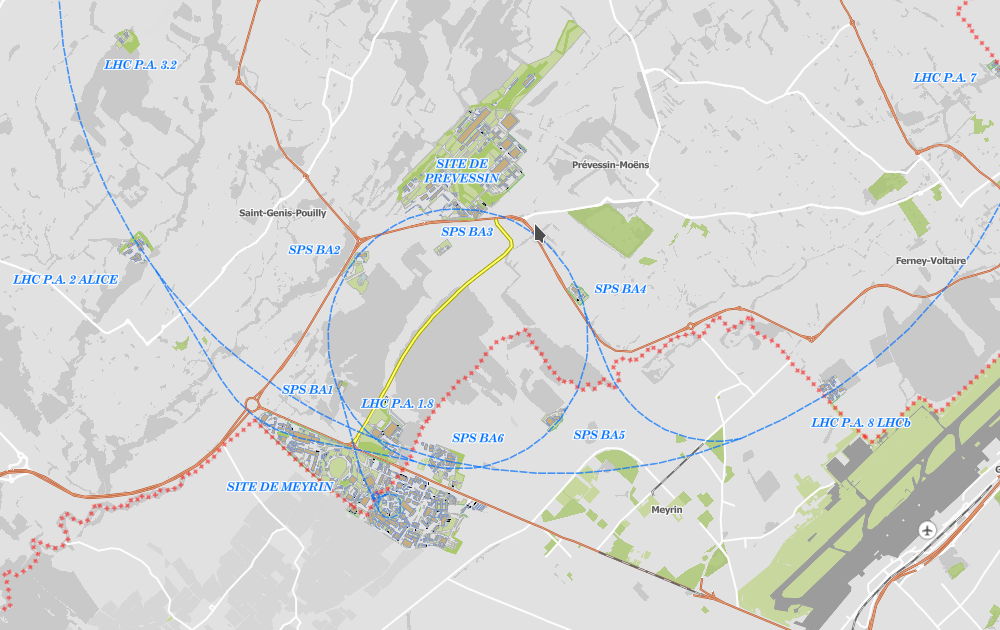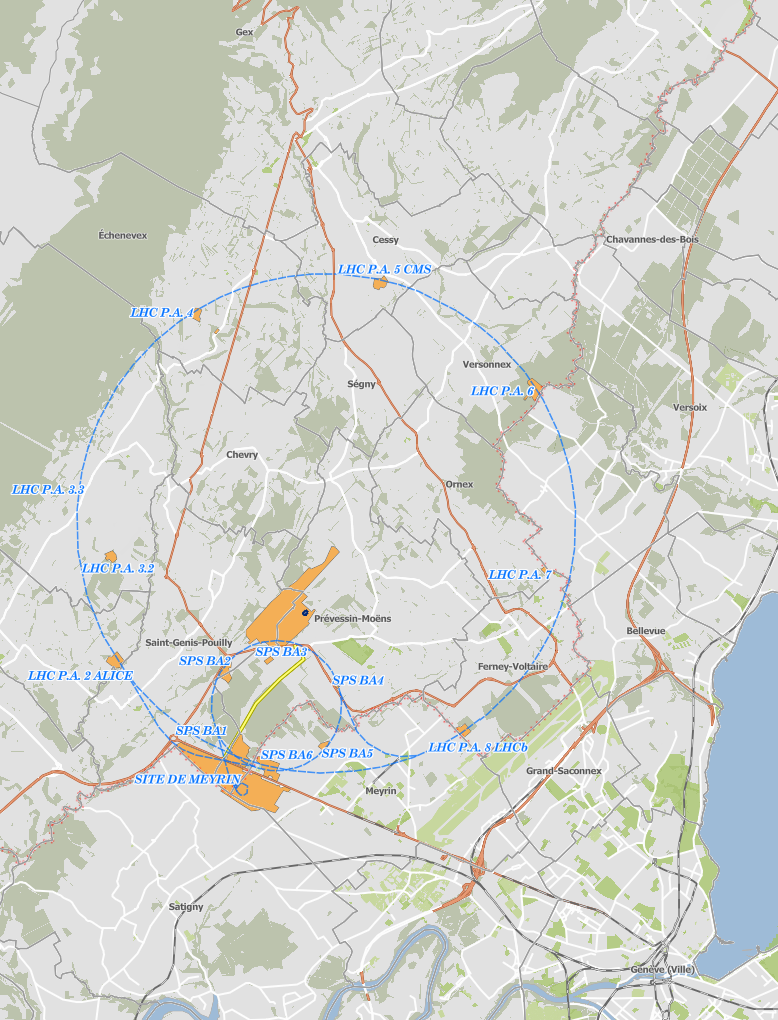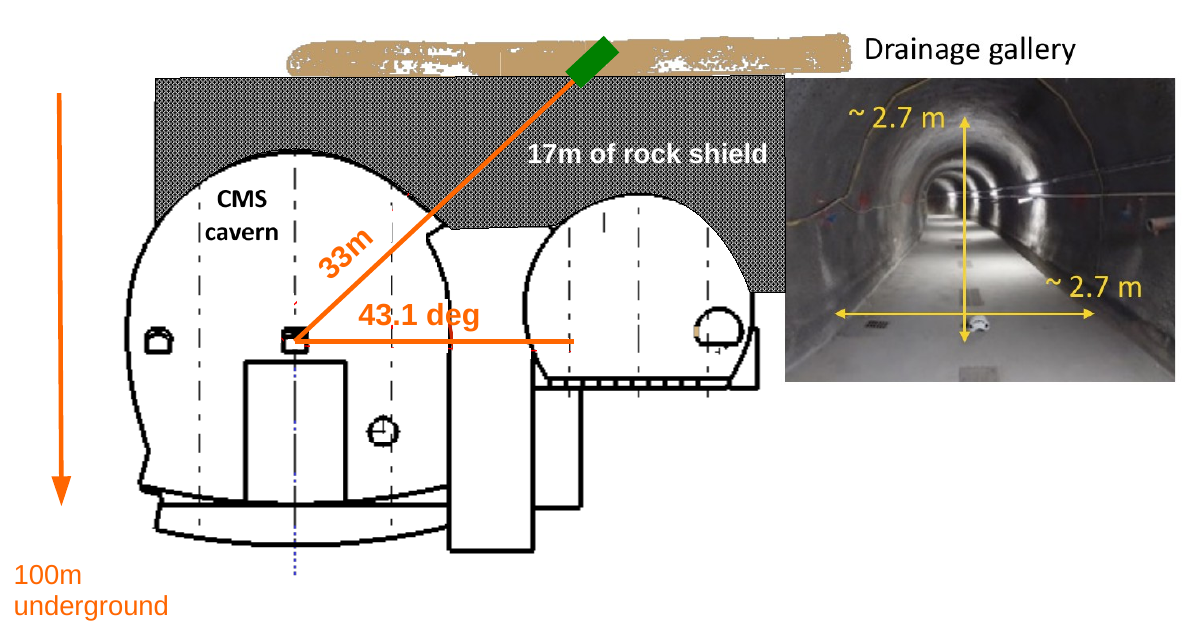VUB Physics Students Visit
CERN
Visit of the Physics and Astronomy students from the Vrije Universiteit Brussel (VUB) to CERN.
-
-
17:00
→
22:00
Arrival at CERN 5h
-
17:00
→
22:00
-
-
09:00
→
09:30
Speakers: Michael Tytgat (Vrije Universiteit Brussel (BE)), Steven Lowette (Vrije Universiteit Brussel (BE))
-
09:30
→
09:45
Transport to Prevessin 15m
The CERN site of Prevessin is located next to the French village Prevessin-Moens. This is the second large experimental CERN site, apart from the main CERN site of Meyrin. Unlike the Meyrin site, which is located on the French-Swiss border but in practise is as if in Switzerland, the Prevessin site is fully in French territory.
The site was built on the north end of the 6.9km SPS accelerator ring
https://home.cern/science/accelerators/super-proton-synchrotron
https://en.wikipedia.org/wiki/Super_Proton_Synchrotronwhich was the accelerator at which, among other things, the W and Z bosons were discovered 40 years ago. Nowadays the SPS is a pre-accelerator for the LHC, but at the same time also several secondary beams are extracted that feed quite a few experiments, like NA62 (NA stands for “North Area”).
Given this concentration of activities, it is not a surprise to find the CERN Control Centre (CCC) there, the main hub from where the complex CERN accelerator system is steered. The site also hosts the control centre of the AMS experiment (an anti-matter experiment on the ISS), a large are for CMS activities including muon labs; (and a very enjoyable barbecue area :) ).
Also the VUB has had recent activities on this site: a few of the silicon tracking modules that were recently constructed in our labs were tested for an extended time in a high-energy muon beam. A picture with one of our postdoctoral researchers working on this is below:
In the map below, you can see the Meyrin and Prevessin sites, and the circular SPS accelerator between them. The small circle in the Meyrin site is the PS accelerator, an even smaller (and older) accelerator that is the step before protons enter the SPS. The biggest circle which we only partially see on this picture is the LHC tunnel.

-
09:45
→
10:50
CERN Control Center Visit 1h 5mSpeaker: Maarten Litmaath (CERN)
The CERN Control Centre is the heart of the accelerator control. From the creation of the protons in the Linac, over the Proton Synchrotron, the PS Booster, the Super Proton Synchrotron, and then injection in the LHC – the operation of the LHC requires an enormously complex machinery to all come together and seemlessly link up with each other: cryogenics, power, vacuum, and of course the accelerator itself. This all happens through coordination from the CCC.
The accelerator and experiments of course also need to talk to each other – the needs, constraints, and wishes of how the LHC should run, what parameters to tune, etc is sometimes very different between experiments and the accelerator. Regular discussions are thus needed, both on the day-to-day level, as on the longer-term strategy. And also directly: the experiment control rooms and the CCC are in regular phone contact with each other, and follow each other's activities.
You can find a description of the day-to-day life at the CCC from a few years back here:https://home.cern/news/news/accelerators/day-cern-control-centre
-
10:50
→
11:10
Transport to LHCb 20m
-
11:10
→
12:00
LHCb Exhibition Visit 50mSpeaker: Maarten Litmaath (CERN)
LHCb is one of the four large detectors at the LHC, with a special focus on the physics of B hadron decays. Studying the often very rare decays of these particles copiously produced in proton collisions gives insights into a range of topics from CP violation (do you see it in the LHCb logo?), over lepton flavour universality, probes of new physics at very high-mass, up to exotic hadrons. Did you know that LHCb discovered most particles at the LHC of all experiments, 60 already? Here is an overview of all new hadrons found at the LHC:
https://www.nikhef.nl/~pkoppenb/hadrons//Masses.pdfAmong these are tetraquark and pentaquark states – very important discoveries for the study of the strong force.
Given LHCb's focus on B-hadron decays, it also has a very different detector design than CMS and ATLAS. Indeed, most B hadrons are produced in a rather forward direction, which is the reason for the rather asymmetric design. They also have several detectors specifically geared towards particle identification, such that decay modes can be more easily unravelled. Also a peculiarity of LHCb is that the LHC does not collide at full intensity at their interaction region. They collect less data than CMS and ATLAS, to avoid having too many overlapping collisions (pileup) confuse the reconstruction of the particles that are emitted in the detector.
On their public website, you may find a short intro video and explore further:
https://lhcb-outreach.web.cern.ch/ -
12:00
→
12:15
Transport to Prevessin 15m
-
12:15
→
13:30
Lunch at Resto 3 1h 15m
-
13:30
→
14:00
Transport to P5 30m
The access points to the LHC tunnel (the previous LEP tunnel) are numbered from 1 to 8. Point 1 (next to the main CERN site in Meyrin) houses the ATLAS experiment, Point 2 the Alice experiment, Point 8 the LHCb experiment, and Point 5 (in the far north of the ring near the village of Cessy) the CMS experiment. The other points house other services for the LHC: for instance Point 4 is where the beams receive a little accelerating push at every of their 11'000 passages per second, while Point 6 is where the LHC proton beams, which carry an enormous amount of energy, can be safely disposed of in the “beam dump”.
Point 5 is visible from far in the countryside because of its main high building in which the CMS detector was constructed, with a diameter of 15m and a length of about 25m. After a lot of testing of the CMS detector in the surface hall, the detector was lowered underground in pieces by a huge crane through a large access shaft. The central piece with the undivisible magnet was the heaviest, about 2000 tons, to lower 100m down.
On the site at Point 5 you will also find many other buildings housing services for the CMS experiment. Of note are the control room and the on-site computing resources for the so-called “High-Level Trigger”, a system that makes sure the dataflow is reduced to a managable level for the subsequent computing services – only 0.003% of the collisions is selected to be kept.
Below you find an overview map with the full LHC ring and the surrounding region, from Geneva with the Rhone river in the south, to the village of Gex at the feet of the Jura mountains in the north. The gray line with red hatching is the border between France and Switzerland.

-
14:00
→
15:30
CMS Visit 1h 30mSpeakers: Michael Hoch (Florida State University (US)), Mick Storr (University of Birmingham (GB))
CMS is one of the four large experiments around the LHC that are built in large underground halls.
At these locations, the proton beams of the LHC are brought together into one beampipe, focused and collided in the center of the detector.
CMS can be seen as a large onion built around the collision point, with layers of detectors each with their own specific task. Closest to the collisions is the track detector to measure momenta of charged particles, then comes the electromagnetic and hadronic calorimeter that measure energies of particles that interact respectively via the electromagnetic (photons, electrons) or hadronic (mesons and baryons, mostly charged pions, protons and neutrons) interaction, and in the outer layers are muon chambers that allow us to track the few muons that are being produced, heavy siblings of the electron that travel all the way through as they do not leave much energy in the detector. A central piece is the very strong magnet that bends the charged particles, and makes it possible to estimate their momenta very accurately.
You may find a general introduction to these components (but also other items like the detector construction of the data handling) here:
On the right side you see a menu with details on the detector. Clicking on these items opens new pages, but also sometimes further subitems with even more information.
The VUB takes part in CMS since almost 30 years already, and in particular played a large role in the construction and operation of the inner silicon strip tracker. We also host one of the large so-called “Tier-2” computing centres for the experiment. At this moment, in the labs on the ground floor of VUB's building G, advanced equipment is being prepared to build again a large tracking detector as an upgrade for the current tracker, that will come to the end of its lifetime in 2025.
-
15:30
→
16:00
milliQan Visit 30mSpeakers: David Vannerom (Vrije Universiteit Brussel (BE)), Steven Lowette (Vrije Universiteit Brussel (BE))
Collisions in CMS produce gazillions of particles, but most of these (except muons) are readily absorbed by the heavy material of the CMS detector. One of the hypotheses for new physics beyond the particles that we know could be the presence of particles with a small electric charge, which would easily fly out of the detector. A few years ago, a new small detector was proposed to capture such particles, to be placed in an unused gallery above the CMS experiment. In 2019, VUB joined in on this experiment, and at this very moment we are finalizing construction of a first version of this detector that will take data during the LHC Run3 years 2023-2025.
A sketch of the detector and its positions with respect to CMS can be seen below. Unfortunately, it is not possible to visit the detector itself, but we will pass by the platform in the main CMS construction hall where the milliQan detector was constructed and tested before it was brought downstairs.
More info in a news item from Oct '22: https://cms.cern/news/milliqan-getting-ready-have-look-dark

-
16:00
→
16:30
Transport to Meyrin 30m
-
16:30
→
17:30
Free visit of the CERN Globe 1h
CERN's usual scientific exhibition (it was named "microcosm") is temporarily closed, awaiting the big constructions to finish in that area, and a new outreach experience centre to open (Summer 2023?).
In the mean time, we can visit CERN's Globe of Science and Innovation, featuring a more broad-public exhibition centre.
https://en.wikipedia.org/wiki/The_Globe_of_Science_and_Innovation
Across the street, in the visitor entrance in B33 there is also a shop with lots of goodies you may want to check out.
Remember:
https://i.pinimg.com/originals/69/57/56/695756f69ecc1bef3d973424d4816c5c.gif
-
09:00
→
09:30
-
- 09:00 → 10:30
-
11:00
→
12:00
Antiproton Decelerator Hall Visit 1h AD
AD
CERN
Speakers: Adriaan Rijllart, Elise Wursten (RIKEN)Since there is going to be a seminar on anti-matter before this visit, we can be very brief here.
This corner of the CERN accelerator complex is called the antiproton decelerator because to make antimatter, you need to first slow down protons before you can trap them in a magnetic field. And then you can do very fundamental physics: high-precision spectroscopy of anti-hydrogen (spoiler: just the same as hydrogen), tests of CPT invariance, tests of gravity on antimatter, and much more.
-
12:15
→
13:45
Lunch at Restaurant 2 1h 30m
CERN Restaurant 2 is less frequented by the occasional visitor, but still a well-known treasure in the CERN social life. It has in particular a terrace that allows, weather permitting, lunch with mountain view, next to the vineyards. Menu meals can be found upstairs, pasta and pizza's downstairs (if things didn't change since my last visit…). It also serves as a great place to have a coffee, and hosts several of the social clubs for those who are CERN-based: yoga club, ski club, etc.
Location:
https://www.google.com/maps/place/CERN+Restaurant+2/@46.2317808,6.0364333,16z/data=!4m10!1m2!2m1!1scern+restaurant+2!3m6!1s0x478c63bc82f9156b:0xa8447db084d13cac!8m2!3d46.2317808!4d6.044673!15sChFjZXJuIHJlc3RhdXJhbnQgMloTIhFjZXJuIHJlc3RhdXJhbnQgMpIBCnJlc3RhdXJhbnTgAQA!16s%2Fg%2F11qh20_kjc
-
14:00
→
14:50
Data Centre Visitors Point Visit 50m DCVP
DCVP
CERN
Speaker: Maarten Litmaath (CERN)CERN has always been at the forefront of computing and data challenges. Even before the advent of detectors with electronic readout, significant (for those times) volumes of information from eg. bubble chamber pictures needed processing, and complex mathematical calculations and physics simulations were and still are a must.
With the LHC, the challenge posed by the data volumes to be processed has reached a level where worldwide cooperation is needed between the research institutes. A worldwide network of computing, with CERN as central “Tier-0” node, provides the experiments with the computing power needed to store the ~15 petabyte of data generated each year, process it in multiple levels of reconstruction of the underlying physics, and distribute it around the world. Also simulations take up a huge chunk of computing power, with order-of-magnitude similar demands in terms of CPU power and storage as the data itself.
The majority of CERN's computing needs are dealt with using open-source platforms and software. CERN itself also invests a lot in R&D in computing and software, and returns many tools to the worlwide scientific and broader community. The most known is the world-wide-web, for which the protocols and first servers were pioneered at CERN, and released free-of-charge to the world – a spark that kindled the explosion of the internet.Sir Tim Berners-Lee, at CERN at that time, made this breakthrough a reality; but did you know that also a Belgian from Tongeren, Robert Cailliau, played a crucial role in this development?
Check him out: https://en.wikipedia.org/wiki/Robert_Cailliau
Other challenges appear with such data volumes and computing demands: high-speed reliable networking, mass long-term storage, security, portability, data preservation, public data releases, etc.More information can be found on this page: https://home.cern/science/computing
Also the VUB is very active on the computing side. With the other Belgian institutes in CMS, we host a large “Tier-2” computing facility in Brussels, which provides services to the CMS experiment – in particular in terms of simulation – and serves as a powerful computing hub which our researchers use extensively to perform analysis, develop tools, calibrate data, etc. -
15:00
→
15:30
Synchrocyclotron Visit 30mSpeaker: Maarten Litmaath (CERN)
The synchrocyclotron was CERN's first accelerator, operational since 1957. While CERN is a champion in recycling (eg. the Proton Synchrotron accelerator is operational since 1959 and still curcial in delivering protons to the LHC), the synchrocyclotron deliverd “only” 33 years beams for science. The simple principles of alternating acceleration and bending in half circles are also what powers many cyclotrons in hospitals and other places nowadays.
One of the first science results was the discovery of the charged pion → e + neutrino decay, a rare decay mode with probability ~10^(-4), whereas the similar decay to muon and neutrino has probability near 1. The reason for the very different behaviour of electron and muon lies in something called helicity suppression – you may have worked through the math yourself before. Back in those days, this was a discovery-level result.
Since a few years, this first accelerator has been made into a beautiful exhibition item, reminiscing some of CERN's early history.
A page with some info is here:
https://home.cern/science/accelerators/synchrocyclotron -
16:10
→
16:40
ATLAS Visitor Centre Visit 30mSpeaker: Maarten Litmaath (CERN)
The ATLAS detector is them big sibling of CMS, neatly placed in Point 1 across the LHC ring.
It has very similar physics program, but has chosen often very complementary detector design with respect to CMS choices. Characteric for ATLAS is the very large outer magnet system generating a toroidal field that bends particles along z; a much lighter outer structure (ATLAS would float on water, CMS would sink), and an electromagnetic calorimeter with a characteristic accordian structure. The downside of being so big is that one cannot see the whole detector when downstairs (so we stay on the surface); the most famous picture where you can still see all was taken during construction (see below).
The ATLAS Collaboration is also somewhat larger than CMS, but in many respects they are similar in purpose and structure. In the early nineties, particle physicists in Belgium wisely decided to put all eggs in one basket and chose to stick to one big future project at the LHC. That's why we now have no participation in ATLAS. The Netherlands did the opposite: they joined ATLAS instead of CMS.
The choice to build 2 experiments with similar purpose serves two purposes. On the one side, a discovery is a big claim to make, and – to quote Carl Sagan – extrordinary claims require extraordinary evidence. And this is exactly what happened with the Higgs boson discovery in 2012. In a spirit of friendly though fierce competition, the two expimerents presented the discovery together, after independently, and with very complementary techniques, the same underlying physics had been unearthed.On the other side, it also is a more mundane insurance for things going really wrong. Since all these machines are their own prototypes, developing a lot of needed technology on the way, it requires half a miracle (no kidding, just amazing scientists and engineers) to make everything come together and actually work. Accidents do happen (and have happened, also with CMS!), so better to be prepared.
ATLAS has a neat website where you can explore more:
https://atlas.cern/Discover/Detector
-
17:00
→
17:30
Speakers: Michael Tytgat (Vrije Universiteit Brussel (BE)), Steven Lowette (Vrije Universiteit Brussel (BE))

